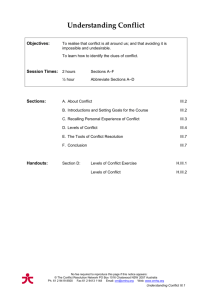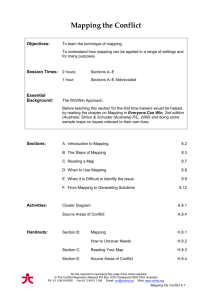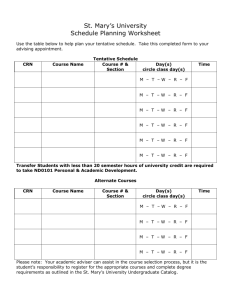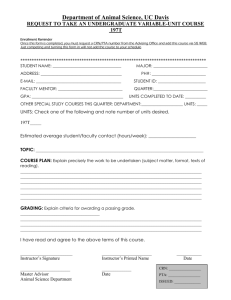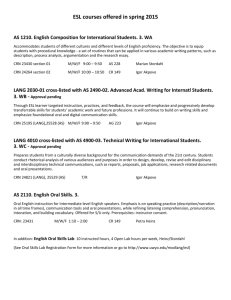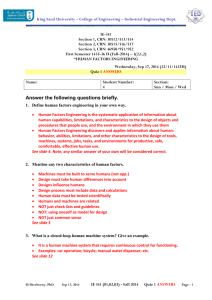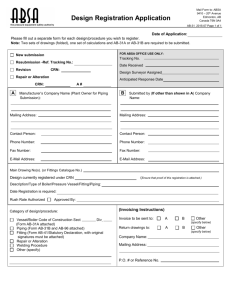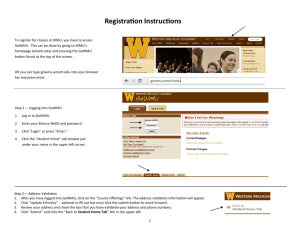Icebreakers and Energisers - Conflict Resolution Network
advertisement
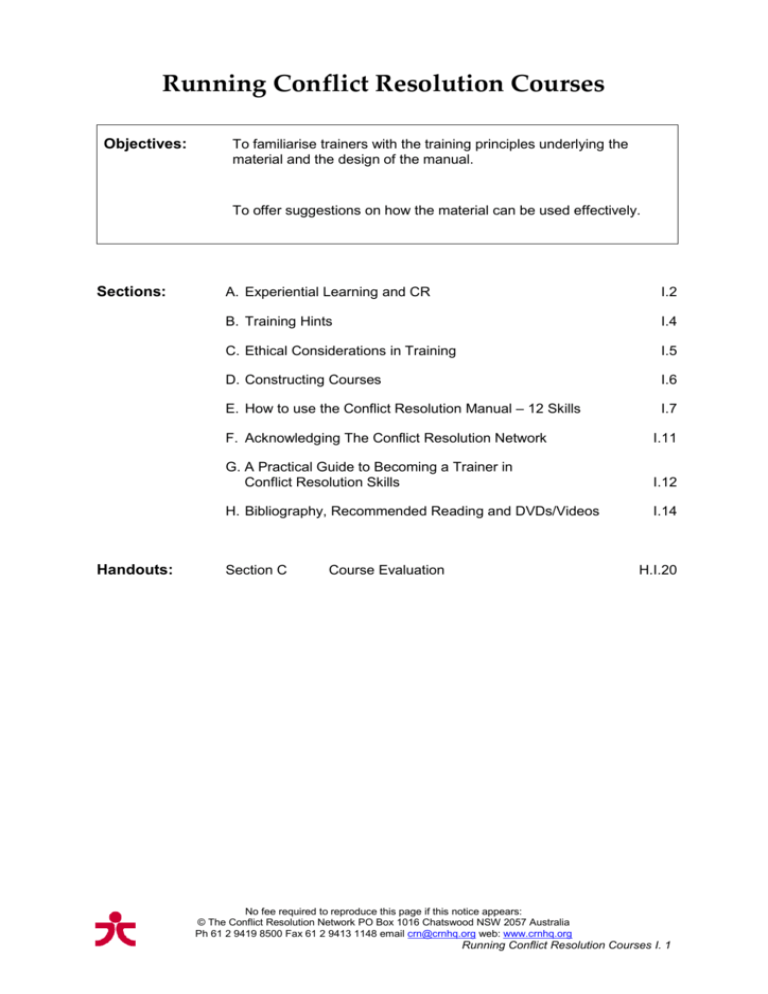
Running Conflict Resolution Courses Objectives: To familiarise trainers with the training principles underlying the material and the design of the manual. To offer suggestions on how the material can be used effectively. Sections: Handouts: A. Experiential Learning and CR I.2 B. Training Hints I.4 C. Ethical Considerations in Training I.5 D. Constructing Courses I.6 E. How to use the Conflict Resolution Manual – 12 Skills I.7 F. Acknowledging The Conflict Resolution Network I.11 G. A Practical Guide to Becoming a Trainer in Conflict Resolution Skills I.12 H. Bibliography, Recommended Reading and DVDs/Videos I.14 Section C Course Evaluation H.I.20 No fee required to reproduce this page if this notice appears: © The Conflict Resolution Network PO Box 1016 Chatswood NSW 2057 Australia Ph 61 2 9419 8500 Fax 61 2 9413 1148 email crn@crnhq.org web: www.crnhq.org Running Conflict Resolution Courses I. 1 Running Conflict Resolution Courses A. Experiential Learning and CR "I still remember the material covered in the Conflict Resolution course two years ago, and I keep using it every day." These are words trainers love to hear. CR trainers hear them frequently. Learning means change. It means change in how we think and how we act. It involves altering our mental processes, expanding and adapting our repertoire of behaviours, and reviewing our habits. Using an interactive and experiential approach makes it much more likely that participants will consistently implement CR attitudes and skills in their workplace, community and personal lives. Participants bring with them the ideas, intuitions, and behaviours they have spent a lifetime building. Trainers usually have only a brief time in which to encourage effective learning, and real and useful change. How is this best achieved? Identify Participants' Current Views Help participants to recognise and clarify their current ideas and behaviours, and assess the usefulness of these ideas in resolving conflicts in their lives. This heightens their interest in learning effective alternative ideas and strategies. Help Participants Construct Their Own Understandings Training isn't about just giving people a new set of ideas. The ideas have to fit into a framework of what they already know. You activate the framework by discussing their current views first of all and then help them make new links to the material you are presenting. New meanings are not transferences by the trainer; they are transformations by the learner. Be Aware of Participants' Level of Readiness to Learn Participants in a course will be ready to learn if they are there voluntarily, and if they identify problems and their limitations in solving them. If participants are not yet "ready", it is not advisable to proceed too far. Instead, work on encouraging their commitment, identifying their needs, and getting them to recognise the weaknesses in their current ideas and behaviours. No fee required to reproduce this page if this notice appears: © The Conflict Resolution Network PO Box 1016 Chatswood NSW 2057 Australia Ph 61 2 9419 8500 Fax 61 2 9413 1148 email crn@crnhq.org web: www.crnhq.org Running Conflict Resolution Courses I. 2 Use a Variety of Interactive Approaches Learning occurs by engaging the participant actively in the process. Use lots of questions. Questions hook the mind. (They are bold in the text so the trainer can glance down to find them easily.) Encourage a debate and discussion within the confines of your time limits. This will be most fruitful if your questions do not require the ''right" answer. Try to treat all answers as a contribution to the group's understanding. When people are assured that they won't be made ''wrong'' they are far more likely to contribute actively. The attitude shifts and understandings you are working towards can usually be elicited from the group, by astute questioning. They are more likely to become part of the person's behavioural repertoire if they can say "I thought of that myself". Always structure a session with some activities which require active participation. People need to talk and practise. People love stories. Tell personal anecdotes that illustrate a point. Keep them short and relevant to the group's purpose. With the same provisos encourage participants to personalise the materials with their own stories. Wherever possible, work on current conflicts experienced by participants. This heightens the significance of the example. Active investigations and practical experiences are especially valuable because they engage participants in moving repeatedly between mental concepts and actual behaviours. Be Precise People also need to be reminded of what they have learnt and what they are about to learn. Use introductions, summaries, and blackboard key points to focus and reinforce learning. This manual will help you be precise about the teaching points you are getting across. Woolly thinking does not promote change. Sharp clarity does. Use Language Appropriately Ideas are made and shared using language. Where the vocabulary and syntax is precise and engaging (without being pedantic and overblown), the ideas can more clearly be expressed, recognised and adapted to the uses of the participants. Many CR words have distinctive meanings and usages, even though they also appear in common use. Draw attention to how these words are deliberately distinctive, or confusion and distortion will easily occur, e.g. the distinction between mediation and arbitration. No fee required to reproduce this page if this notice appears: © The Conflict Resolution Network PO Box 1016 Chatswood NSW 2057 Australia Ph 61 2 9419 8500 Fax 61 2 9413 1148 email crn@crnhq.org web: www.crnhq.org Running Conflict Resolution Courses I. 3 B. Training Hints Group Size A group of 12–25 works well. Larger groups benefit from more activities and small groups discussions. Also consider two trainers for large groups. Seating Optimum seating arrangement is circular or semi-circular. It is essential that chairs are movable so that participants can do the activities. Flip chart/whiteboard/blackboard: Use a board, preferably with flip chart paper, to record key points and catch phrases as they emerge for visual reinforcement. Coloured Pens Ideally use a variety of coloured pens to distinguish headings and points, and make board notes visually interesting. Methods Use a range of training methods to provide variety and to suit the different ways that people like to learn e.g. large and small group discussion, role plays, simulations, completion of handouts, minilectures etc. Handouts Give out most handouts at the end of a session so that participants focus their attention on the discussion and developing their own ideas rather than on reading the handouts. Bibliography for Training Presentation Techniques Clarke, Jean Illsley Who, Me Lead a Group (USA: Parenting Press, 1998) Hamer, Kerri Leading a Group (Sydney: Kerri Hamer, 1997) Kroehmert, Gary Basic Training for Trainers (2nd Edition) (Australia, McGraw Hill Books Co, 1995) No fee required to reproduce this page if this notice appears: © The Conflict Resolution Network PO Box 1016 Chatswood NSW 2057 Australia Ph 61 2 9419 8500 Fax 61 2 9413 1148 email crn@crnhq.org web: www.crnhq.org Running Conflict Resolution Courses I. 4 C. Ethical Considerations in Training Conflict Resolution sessions involve both emotions and opinions, and so there are important obligations between trainer and participants, and amongst the participants. Some of these require attention during planning, and some arise during the interactions within the sessions themselves. It is the responsibility of trainers to: explain the intentions and objectives at the start of the course, the sessions and the activities. It needs to be clear what the participants can expect. discuss the need for confidentiality as a protection and an encouragement to everyone's honest and free participation. Consensus needs to be reached as to the level and type of confidentiality everyone can abide by, before the course commences. ensure that the privacy of trainers and participants is respected. Activities and discussions need to allow people to expose only as much personal information as they wish. minimise the amount of time they and some participants use when monopolising or rambling. This reduces participants' energy and enthusiasm, distracts from the effective pursuit of the session's objectives, and wastes the group's resources. ensure that there is sufficient debriefing discussion time at the end of activities for participants to talk through what they felt. In this way, participants can leave the session cleared of the strong emotions activities often evoke. state clearly that participants have the freedom not to participate in an activity. It is usually helpful to encourage participants to push through minor reluctance, but strong discomfort needs to be respected. be aware of signs of emotional distress in any participant. A session should never be planned or executed for this to happen deliberately, and trainers need to watch for such signs so the activity or discussion can be diverted to minimise the person's hurt and allow them to recover. Trainers need to be ready to support these participants and refer them to appropriate competent support. be alert to (and, indeed, actively seek) feedback from participants. Sessions need to be adjusted to deal with emerging issues and needs, wherever appropriate. Courses also need to be evaluated formally by the participants as to the matter and manner of the course, and the performance of the trainer. See the handout: "Course Evaluation'' No fee required to reproduce this page if this notice appears: © The Conflict Resolution Network PO Box 1016 Chatswood NSW 2057 Australia Ph 61 2 9419 8500 Fax 61 2 9413 1148 email crn@crnhq.org web: www.crnhq.org Running Conflict Resolution Courses I. 5 D. Constructing Courses Applying These Skills The skills in this manual are useful in the workplace and in personal life. In workplace settings, it is appropriate for the trainer to mostly use workplace examples. However, employers and training officers are recognising increasingly that wherever people learn skills to resolve their personal disputes, they increase workplace productivity. Both workplace and personal examples are suitable, then, as the skills are transferable. Names For Courses Market courses in conflict resolution under a variety of names such as: The Skills of Conflict Resolution Resolving Conflict Constructively Creative Communication Communicating for Success Workplace Communication Creative Problem Solving. Include conflict resolution materials in courses such as: Stress Management Effective Parenting Team Building Grievance Handling Change Management Classroom Management Leadership Achieving Peak Performance. No fee required to reproduce this page if this notice appears: © The Conflict Resolution Network PO Box 1016 Chatswood NSW 2057 Australia Ph 61 2 9419 8500 Fax 61 2 9413 1148 email crn@crnhq.org web: www.crnhq.org Running Conflict Resolution Courses I. 6 Needs Analysis If participants are enrolling in an advertised course, obtain a clear picture of their needs and interests at the start of the course. This can be done when individuals introduce themselves in turn around the circle, or more formally by giving out a needs survey. If, instead, the course is being tailored to meet the specific needs of a group or organisation, send out a questionnaire designed particularly for the group or interview participants beforehand to ascertain their needs. Collating the results will help guide the trainer in ordering (and possibly selecting) the skills, activities and examples. Skills Sequence An understanding of what conflict is, the Win/Win Approach, and moving from reaction to response form the foundation for all the other skills. Vary the sequence in which the skills are covered to suit the needs and interests of participants. Course Duration Sometimes a request is made for a seminar with a particular focus such as "managing emotions". However, when the brief is ''...a course in conflict resolution", consider the following suggestions. 3 days: explore the key concepts of all the twelve skills, with numbers of activities to reinforce learning. 2 days: focus on nine or ten skills, possibly omitting negotiation and mediation. 1 day: consider Understanding Conflict, The Win/Win Approach, Empathy (listening skills), Appropriate Assertiveness ("I" statements), and Mapping. ½ day: explore the nature of conflict The Win/Win Approach, and one of the interaction skills, such as Assertiveness or Empathy. E. How to use the Conflict Resolution Manual – 12 Skills Finding Content Table of Contents: chapter titles. Index: details of chapters including activities and handouts Chapter Title Pages: objectives, essential background, session times, details of sections within the core material, activities and handouts. Chapter Numbers No fee required to reproduce this page if this notice appears: © The Conflict Resolution Network PO Box 1016 Chatswood NSW 2057 Australia Ph 61 2 9419 8500 Fax 61 2 9413 1148 email crn@crnhq.org web: www.crnhq.org Running Conflict Resolution Courses I. 7 Chapters are identified, both with a written title and a number. Two number systems are used: Standard Numerals: 1–12 Two Roman Numerals: I, II... The standard numerals are to identify the chapters that cover the twelve skills of conflict resolution, and correspond to the order of presentation in some other materials produced by The Conflict Resolution Network. The Roman numerals identify all other chapters. This chapter is the only chapter which does not contain training material. Components of Each Chapter In Chapters 1–12, there are three components: Core material: this includes the key concepts of each skill, presented in a way that facilitates interaction between and amongst the participants and the trainer. It also includes activities which either: are simple to explain and do not interrupt the flow and sense of the main material; and/or, are considered as essential to train participants in the core material. Activities: this includes role plays, simulations, guided reflections, handouts and small group discussions. Within the core material, trainers are directed to the activity section, as in the example below: Handling Another Person's Inflammation: a role play in which participants practise active listening skills (see Managing Emotions Activities A.6.6). (20 minutes) No fee required to reproduce this page if this notice appears: © The Conflict Resolution Network PO Box 1016 Chatswood NSW 2057 Australia Ph 61 2 9419 8500 Fax 61 2 9413 1148 email crn@crnhq.org web: www.crnhq.org Running Conflict Resolution Courses I. 8 The activities are placed in the order that correspond to the order in which they arise in the core material. Handouts: this includes all the handouts which are referred to in the core material and in the activities. Instructions to distribute a handout appear in the text as in the example below: Give out the handout: ''Discovery Circle'' The handouts are placed in the same order as they appear in the core material and in the activities. Timing Timing for sessions will vary depending on the emphasis a trainer wishes to give to the material, and on the participants' needs and interests. As a guide, approximate times are given throughout the manual. On the title page of each chapter, session times are given. These include the time it would take to run each section including its accompanying activities. Throughout the chapter, times for running a whole section are given in bold as in the example below: E. Discovery Circle (1hour) The (1 hour) includes the time it would take to cover the core material plus run the accompanying activity. Within each section the time it would take to run the activity component is also specified not bolded. So in Section E. Discovery Circle, the activity is listed as follows: Power Game Triangle & Discovery Circle Game: Part 2 : participants do...etc (45 minutes) At the beginning of each activity in the shaded area headed Trainers' Information Only, the time it will take to run that activity is also listed. Page Numbering Activities and Handouts have their page numbers prefixed by ''A'' and ''H'' respectively. So, for example, within Chapter 1. The Win/Win Approach, pages appear as Core material: 1.1 , 1.2, 1.3 etc Activities: A.1.1, A.1.2, A.1.3 etc Handouts: H.1.1, H.1.2, H.1.3 etc. No fee required to reproduce this page if this notice appears: © The Conflict Resolution Network PO Box 1016 Chatswood NSW 2057 Australia Ph 61 2 9419 8500 Fax 61 2 9413 1148 email crn@crnhq.org web: www.crnhq.org Running Conflict Resolution Courses I. 9 Typefaces within the Text Bold: a key point and/or needs special care with expression – perhaps say it verbatim. Questions to be posed by the trainer to the group are also written in bold Italics: an instruction to trainers (not to be said directly to participants). Section Separators Trainers printing out the whole manual may choose to use two different colour papers for activities and handouts. If you choose to buy a hard copy of the manual (see Resources on the website: www.crnhq.org) the various sections are printed on different papers with a plastic sleeve o handout masters for photocopying for participants is stowed at the back of the manual. No fee required to reproduce this page if this notice appears: © The Conflict Resolution Network PO Box 1016 Chatswood NSW 2057 Australia Ph 61 2 9419 8500 Fax 61 2 9413 1148 email crn@crnhq.org web: www.crnhq.org Running Conflict Resolution Courses I. 10 F. Acknowledging The Conflict Resolution Network The materials in this manual are the copyright of The Conflict Resolution Network. You may reproduce sections in your own training material provided our copyright notice appears. The document is available for download from our website in Microsoft Word to facilitate this process. Any handout may be reproduced if the acknowledgement notice in the bottom border appears. If a new handout is developed for a specific purpose, which is based substantially on a Conflict Resolution Network handout, these words should appear on the new handout: Adapted from materials of The Conflict Resolution Network, PO Box 1016, Chatswood NSW 2057, Australia www.crnhq.org As well, anyone who wishes to indicate their association with The Conflict Resolution Network and its teaching materials may do so by including the following acknowledgement in their written or spoken material: This program includes content developed by The Conflict Resolution Network, a network of people with a common commitment to Conflict Resolution, co-operative communication strategies and related skills. No fee required to reproduce this page if this notice appears: © The Conflict Resolution Network PO Box 1016 Chatswood NSW 2057 Australia Ph 61 2 9419 8500 Fax 61 2 9413 1148 email crn@crnhq.org web: www.crnhq.org Running Conflict Resolution Courses I. 11 G. A Practical Guide to Becoming a Trainer in Conflict Resolution Skills The Conflict Resolution Network receives many phone calls from people interested in becoming consultants and trainers in Conflict Resolution Skills. People are often uncertain how to go about it. Here is a step-by-step guide. Gain a thorough understanding of CR skills. Read the book Everyone Can Win (preferably the 2nd edition which is significantly updated) and the CRN Trainers' Manual. Master the participative and interactive methods used to teach CR, keeping lecture material short. Make the skills part of your own everyday language. Choose where you will first market yourself. If you have never taught before, one of the best ways of getting started is to form a small study group in your own home or workplace. Find around six people to come along each week to do study sessions together. Prepare well for each session. New trainers might put around eight hours of preparation into a two hour session. Try to do the preparation week by week. Starting with a concentrated two day workshop may require you to absorb too much material all at once. Evening colleges, university extension courses and Adult Education centres are also good starting places. Change the title of your course if other courses on the catalogue sound similar e.g. change to Psychology of Creative Communication, Assertiveness Training, or Communication Skills. (See also suggestions in Section D of this chapter.) Having your course listed does not guarantee an audience. Advertise with letterbox drops, notices at the local library, newsagents and local cafes. This will be greatly appreciated by the organisers. Once you have taught your first CR course, your confidence should grow. Participants usually give positive feedback, and the opportunities for in-depth discussions that arise from studying the materials can be extremely fulfilling. Negative feedback is a great opportunity for improving your skills. Promote a CR course in your areas of expertise e.g. computer training, education, or management. Make CR training an extra string to your bow. Design the course to meet the specific needs of your group. (See Section D of this chapter) For assistance contact: CRN Information Centre Tel: 61 2 9419 8500. Email: crn@crnhq.org No fee required to reproduce this page if this notice appears: © The Conflict Resolution Network PO Box 1016 Chatswood NSW 2057 Australia Ph 61 2 9419 8500 Fax 61 2 9413 1148 email crn@crnhq.org web: www.crnhq.org Running Conflict Resolution Courses I. 12 Work with another trainer, if possible, when you first start. There is a lot to plan and two heads are always better than one. Perhaps you plan to teach a CR course in your own organisation and would like to have an experienced CR trainer co-facilitate. Contact CRN. Join or create a training support group to network with other trainers. CRN is very supportive of trainers moving into the field, but cannot find you the work. That's your task and, indeed, not one to be underestimated. A lot of your time will go into this. Send us an email. CRN loves to hear about your successes and the challenges you face. No fee required to reproduce this page if this notice appears: © The Conflict Resolution Network PO Box 1016 Chatswood NSW 2057 Australia Ph 61 2 9419 8500 Fax 61 2 9413 1148 email crn@crnhq.org web: www.crnhq.org Running Conflict Resolution Courses I. 13 H. Bibliography, Recommended Reading and DVDs/Videos Books and other materials are listed in the skill area for which they are most appropriate. Many are also relevant in other skills areas. Accompanying Text Helena Cornelius and Shoshana Faire, Everyone Can Win 2nd edition. (Sydney: Simon & Schuster (Australia) P/L, 2006)) Throughout the manual this appears as Everyone Can Win. Wherever a substantial CR course is covered, consider supplying all participants with a copy of the text, for long term recall and passing on skills to others. Available through CRN's website: www.crnhq.org Advanced Reading Cornelius, Helena The Gentle Revolution (Australia: Simon & Schuster, 1998) This book explores clashes of values. Although relevant to all value clashes, it focuses on conflicts arising from differences in masculine and feminine perspectives. Many commonly found workplace values conflicts are dealt with. Available through CRN'S website: www.crnhq.org General ABC/CRN The Resolution of Conflict Audio Tapes (Australia: ABC/CRN, 1989) CRN Conflict Kit (Australia: CRN, 1992) CRN Conflict-Resolving Media Broadsheet (Australia: CRN, 1992) CRN Fighting Fair: A Guide (Australia: CRN, 1989) CRN CR Essentials Training Video/DVD (Australia: CRN, 1992) AII CRN resources are available through its website: www.crnhq.org No fee required to reproduce this page if this notice appears: © The Conflict Resolution Network PO Box 1016 Chatswood NSW 2057 Australia Ph 61 2 9419 8500 Fax 61 2 9413 1148 email crn@crnhq.org web: www.crnhq.org Running Conflict Resolution Courses I. 14 Win/Win Approach Judson, Stephanie A Manual on Nonviolence and Children (USA: New Society Publishers, 1984) Luvmour, Sambhava & Josette Everyone Wins (Gabriola Island, BC, Canada: New Society Publishers, 1990) Kerry Patterson, Joseph Grenny, et al. Crucial Conversations (USA: McGraw-Hill, 2002) Weinstein, Matt & Goodman, Joel Playfair (California USA: Impact Publishers, 1980) Creative Response Crum, Thomas F The Magic of Conflict (New York: Simon & Schuster, 1987) De Bono, Edward The Five Day Course in Thinking (Harmondsworth: Penguin, 1968) Gawain, Shakti Creative Visualisation (Toronto: Bantam, 1979) Daniel Goleman Emotional Intelligence (New York: Bantam Books, 1995) Empathy Bolton, Robert People Skills (Sydney: Simon & Schuster, 1988) Egan, Gerard The Skilled Helper (California: Books/cola, 1975) Festinger, Leon A Theory of Cognitive Dissonance (USA: Tavistock Publications, 1959) Mackay, Hugh Why Don’t People Listen? (Australia: William Morrow, 1994) Douglas Stone, Bruce Patton and Sheila Heen, Difficult Conversations (UK: Penguin Books, 2000) Appropriate Assertiveness Back, Ken and Kate Assertiveness at Work (USA: McGraw-Hill,1982) Bolton, Robert People Skills (Australia: Simon and Schuster, 1986) Forgas, Joseph P Interpersonal Communication (Sydney: Pergamon Press, 1985) No fee required to reproduce this page if this notice appears: © The Conflict Resolution Network PO Box 1016 Chatswood NSW 2057 Australia Ph 61 2 9419 8500 Fax 61 2 9413 1148 email crn@crnhq.org web: www.crnhq.org Running Conflict Resolution Courses I. 15 Gordon, Thomas Parent Effectiveness Training (NY, Three Rivers Press, 2000) Phelps, Stanlee The Assertive Woman (USA: Impact, 1987) Senge, Peter M, Kleiner, Art, Roberts, Charlotte, et al. The Fifth Discipline Field Book (USA: Doubleday, 1994) Willis, Liz & Daisley, Jenny Springboard (UK: Hawthorn, 1990) Co-operative Power Dinkmeyr, Don & McKay, Gary Systematic Training for Effective Parenting (Circle Pines, Minn: American Guidance Service, 1976) Dreikurs, Rudolph & Solts, Vicki Children: The Challenge (NY: Hawthorn, 1964) Fabry, Joseph B The Pursuit of Meaning (San Francisco: Harper & Row, 1968) Harris, Thomas A I'm OK, You're OK (New York: Avon, 1973) James, Muriel and Jongeward, Dorothy Born to Win (USA: AddisonWesley,1996) Robbins Anthony Unlimited Power (UK: Simon & Schuster, 1988) Schulz, Will The Truth Option (USA: Ten Speed Press, 1984) Managing Emotions Biddulph, Shaaron & Steve The Making of Love (Sydney: Doubleday, 1988) Rudolf Dreikurs and Vicki Soltz, Children: The Challenge (USA: Plume, paperback ed. 1991). Fisher, Roger and Shapiro, Daniel Beyond Reason: Using Emotions As You Negotiate (London: Random House, 2005) Gendlin, Eugene Focusing: How to Open up your Deeper Feelings and Intuition (USA: Rider & Co, 2003). Jansen, David & Newman, Margaret Really Relating (Sydney: Random House, 1989) Welwood, John Journey of the Heart (London: Mandala, 1990) Henderson, Julie The Lover Within (USA: Barrytown, 1999) Henderson, Julie How to Feel as Good as You Can in Spite of Everything (USA: 1995) No fee required to reproduce this page if this notice appears: © The Conflict Resolution Network PO Box 1016 Chatswood NSW 2057 Australia Ph 61 2 9419 8500 Fax 61 2 9413 1148 email crn@crnhq.org web: www.crnhq.org Running Conflict Resolution Courses I. 16 Willingness to Resolve Campbell, Joseph (ed) The Portable Jung (New York: Penguin, 1971) Dowrick, Stephanie Forgiveness and Other Acts of Love (Australia: Viking, 1997) Dunne, Claire Carl Jung: Wounded Healer of the Soul (New York: Parabola, 2002) O'Connor, Peter Understanding Jung (Melbourne: Mandarin, 1985) Mapping the Conflict Acland, Andrew Floyer Resolving Disputes Without Going To Court (Great Britain: Century, 1995) Acland, Andrew Floyer A Sudden Outbreak of Common Sense (UK: Hutchinson, 1990) Designing Options de Bono, Edward Conflicts – A Better Way to Resolve Them (London: Penguin, 1986) de Bono, Edward Lateral Thinking for Management (UK: Pelican, 1982) de Bono, Edward Serious Creativity (UK: Harper Collins, 1992) de Bono, Edward Six Thinking Hats ( USA: First Back Bay, 1999) Fisher, Roger and Ury, William Getting to Yes: Negotiating Agreement Without Giving In (USA: Penguin, 1991), Negotiation Fisher, Roger and Brown, Scott Getting Together: Building Relationships As We Negotiate (Boston: Houghton/Mifflin, 1989). Fisher, Roger & Ury, William Getting to Yes (London: Business Books, 1981) Frank, Milo O. How to Get Your Point Across In 30 Seconds – or Less (UK: Corgi Books, 1987) Kranitz, Martin A Getting Apart Together (USA: Impact Publishing, 1987) No fee required to reproduce this page if this notice appears: © The Conflict Resolution Network PO Box 1016 Chatswood NSW 2057 Australia Ph 61 2 9419 8500 Fax 61 2 9413 1148 email crn@crnhq.org web: www.crnhq.org Running Conflict Resolution Courses I. 17 Parker, Alan The Negotiator’s Toolkit A Practical Guide to Success in the Home, Office, Factory and Boardroom (Peak Performance Development, Sydney) Stone, Douglas; Patten, Bruce; Heen, Sheila; and Fisher, Roger Difficult Conversations: How To Discuss What Matters Most (USA: Penguin, 1999) Ury, William Getting Past No (UK: Business Books, 1991) Mediation Acland, Andrew Floyer A Sudden Outbreak of Common Sense (London: Hutchinson, 1990) Acland, Andrew Floyer Resolving Disputes Without Going To Court (Great Britain: Century, 1995) Auvine B et al. A Manual for Group Facilitators (USA: Center for Conflict Resolution, 1978) Avery, M et al. Building United Judgement (USA: Center for Conflict Resolution, 1981) Bush, Robert A Baruch and Folger, Joseph P The Promise of Mediation – Responding to Conflict Through Empowerment and Recognition, (San Francisco: Josey-Bass Inc., 1994) Boulle, Laurance Mediation – Principles Process Practise (Australia: Butterworths, 1996) Haynes, John M. Mediating Divorce (San Francisco: Jossey-Bass, 1989) Charlton, Ruth and Dewdney, Micheline The Mediator’s Handbook (Australia: The Law Book Co., 1995) Fighting Fair Poster (Sydney: CRN, 1988. See www.crnhq.org) Meetings Procedures (Sydney: CRN, 1989. See www.crnhq.org) Doyle: Michael & Straus, David How to Make Meetings Work (USA: Jove Books, 1976) Moore, Christopher W The Mediation Process (USA: Jossey-Bass Publishers, 1986) CR Essentials Training DVD/video (Sydney: CRN, 1992) Winslade, John and Monk, Gerald Narrative Mediation – A New Approach to Conflict Resolution (San Francisco: Jossey-Bass. 2000) No fee required to reproduce this page if this notice appears: © The Conflict Resolution Network PO Box 1016 Chatswood NSW 2057 Australia Ph 61 2 9419 8500 Fax 61 2 9413 1148 email crn@crnhq.org web: www.crnhq.org Running Conflict Resolution Courses I. 18 Broadening Perspectives Curle, Adam Mystics & Militants (UK: Tavistock, 1972) Curle, Adam Tools for Transformation (UK: Hawthorn, 1990) Heifetz, Ronald A. Leadership Without Easy Answers (Massachusetts., Belknap Press,1994) Schindler, Craig & Lapid, Gary The Great Turning (USA: Bear & Co, 1989) Goleman, Daniel Emotional Intelligence (New York: Bantam Books, 1995) Aikido Crum, Thomas F Aiki Energiser Video (USA: Thomas F Crum) Crum, Thomas F The Creative Resolution of Conflict (USA: Thomas F Crum, 1985) Crum, Thomas F The Magic of Conflict (USA: Touchstone, 1987) Hyams, Joe Zen in the Martial Arts (USA: Bantam Books, 1979) Tohei, Koichi Ki in Daily Life (Japan: Ki No Kenkyu Kai, 2001) Bioenergetics Lowen, Alexander MD Bioenergetics (New York: Coward, McCann and Geoghegan, 1975) Lowen, Alexander MD & Lowen, Leslie The Way to Vibrant Health – A Manual of Bioenergetic Exercises (USA: Harper Colophon Books, 1977). No fee required to reproduce this page if this notice appears: © The Conflict Resolution Network PO Box 1016 Chatswood NSW 2057 Australia Ph 61 2 9419 8500 Fax 61 2 9413 1148 email crn@crnhq.org web: www.crnhq.org Running Conflict Resolution Courses I. 19 Course Evaluation 1. My major aims or outcomes for doing this course were: ___________________ _________________________________________________________________ _________________________________________________________________ _________________________________________________________________ 2. In what ways did the course meet these? _______________________________ _________________________________________________________________ _________________________________________________________________ _________________________________________________________________ 3. In what ways did the course not meet these? ____________________________ _________________________________________________________________ _________________________________________________________________ _________________________________________________________________ 4. Things I consider the leader/s did well were: _____________________________ _________________________________________________________________ _________________________________________________________________ _________________________________________________________________ 5. What things would you have preferred to be done differently regarding the course and course leader? __________________________________________________ _________________________________________________________________ _________________________________________________________________ _________________________________________________________________ 6. Other comments and suggestions: ____________________________________ _________________________________________________________________ _________________________________________________________________ _________________________________________________________________ 7. How would you rate the course overall? (Tick one) □ Excellent □ Satisfactory □ Very good □ Unsatisfactory □ Good Name (optional): ____________________________________________________ Thank you. No fee required to reproduce this page if this notice appears: © The Conflict Resolution Network PO Box 1016 Chatswood NSW 2057 Australia Ph 61 2 9419 8500 Fax 61 2 9413 1148 email crn@crnhq.org web: www.crnhq.org Running Conflict Resolution Courses H.I. 20
